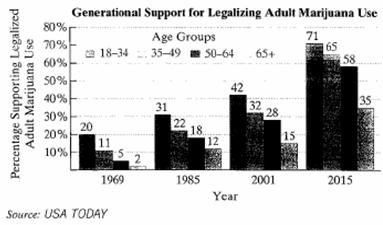
The bar graph shows the percentage of Americans, by age group, supporting legalized marijuana for four selected years from 1969through 2015. Use the information in the graph to write each set inExercises 133-138 in roster form or express the set as

134.
Want to see the full answer?
Check out a sample textbook solution
Chapter 2 Solutions
FD - THINKING MATHEMATICALLY MYMATHLAB
Additional Math Textbook Solutions
Elementary Statistics (13th Edition)
Introductory Statistics
Calculus: Early Transcendentals (2nd Edition)
A First Course in Probability (10th Edition)
College Algebra (7th Edition)
University Calculus: Early Transcendentals (4th Edition)
- The graph of f(x) is given below. Select each true statement about the continuity of f(x) at x = 3. Select all that apply: 7 -6- 5 4 3 2 1- -7-6-5-4-3-2-1 1 2 3 4 5 6 7 +1 -2· 3. -4 -6- f(x) is not continuous at a = 3 because it is not defined at x = 3. ☐ f(x) is not continuous at a = - 3 because lim f(x) does not exist. 2-3 f(x) is not continuous at x = 3 because lim f(x) ‡ ƒ(3). →3 O f(x) is continuous at a = 3.arrow_forward1.5. Run Programs 1 and 2 with esin(x) replaced by (a) esin² (x) and (b) esin(x)| sin(x)|| and with uprime adjusted appropriately. What rates of convergence do you observe? Comment.arrow_forwardIs the function f(x) continuous at x = 1? (z) 6 5 4 3. 2 1 0 -10 -9 -7 -5 -2 -1 0 1 2 3 4 5 6 7 8 9 10 -1 -2 -3 -4 -5 -6 -7 Select the correct answer below: ○ The function f(x) is continuous at x = 1. ○ The right limit does not equal the left limit. Therefore, the function is not continuous. ○ The function f(x) is discontinuous at x = 1. ○ We cannot tell if the function is continuous or discontinuous.arrow_forward
- Use Taylor Series to derive the entries to the pentadiagonal and heptadiagonal (septadiagonal?) circulant matricesarrow_forwardIs the function f(x) shown in the graph below continuous at x = −5? f(x) 7 6 5 4 2 1 0 -10 -9 -8 -7 -6 -5 -4 -3 -2 -1 0 1 2 3 4 5 6 7 8 9 10 -1 -2 -3 -4 -5 -6 -7 Select the correct answer below: The function f(x) is continuous. ○ The right limit exists. Therefore, the function is continuous. The left limit exists. Therefore, the function is continuous. The function f(x) is discontinuous. ○ We cannot tell if the function is continuous or discontinuous.arrow_forward1.3. The dots of Output 2 lie in pairs. Why? What property of esin(x) gives rise to this behavior?arrow_forward
- 1.6. By manipulating Taylor series, determine the constant C for an error expansion of (1.3) of the form wj−u' (xj) ~ Ch¼u (5) (x;), where u (5) denotes the fifth derivative. Based on this value of C and on the formula for u(5) (x) with u(x) = esin(x), determine the leading term in the expansion for w; - u'(x;) for u(x) = esin(x). (You will have to find maxε[-T,T] |u(5) (x)| numerically.) Modify Program 1 so that it plots the dashed line corresponding to this leading term rather than just N-4. This adjusted dashed line should fit the data almost perfectly. Plot the difference between the two on a log-log scale and verify that it shrinks at the rate O(h6).arrow_forward4. Evaluate the following integrals. Show your work. a) -x b) f₁²x²/2 + x² dx c) fe³xdx d) [2 cos(5x) dx e) √ 35x6 3+5x7 dx 3 g) reve √ dt h) fx (x-5) 10 dx dt 1+12arrow_forwardDefine sinc(x) = sin(x)/x, except with the singularity removed. Differentiate sinc(x) once and twice.arrow_forward
- 1.4. Run Program 1 to N = 216 instead of 212. What happens to the plot of error vs. N? Why? Use the MATLAB commands tic and toc to generate a plot of approximately how the computation time depends on N. Is the dependence linear, quadratic, or cubic?arrow_forwardShow that the function f(x) = sin(x)/x has a removable singularity. What are the left and right handed limits?arrow_forward18.9. Let denote the boundary of the rectangle whose vertices are -2-2i, 2-21, 2+i and -2+i in the positive direction. Evaluate each of the following integrals: (a). 之一 dz, (b). dz, (b). COS 2 coz dz, dz (z+1) (d). z 2 +2 dz, (e). (c). (2z+1)zdz, z+ 1 (f). £, · [e² sin = + (2² + 3)²] dz. (2+3)2arrow_forward
 Holt Mcdougal Larson Pre-algebra: Student Edition...AlgebraISBN:9780547587776Author:HOLT MCDOUGALPublisher:HOLT MCDOUGAL
Holt Mcdougal Larson Pre-algebra: Student Edition...AlgebraISBN:9780547587776Author:HOLT MCDOUGALPublisher:HOLT MCDOUGAL
